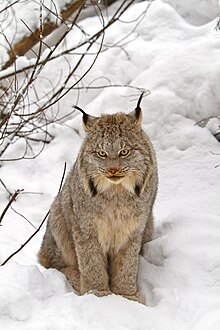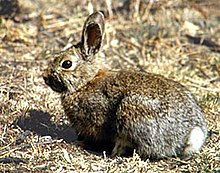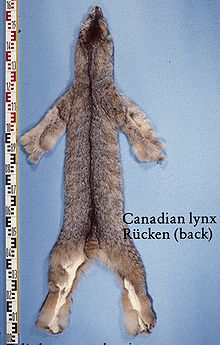Canadian lynx
| Canadian lynx | ||||||||||||
|---|---|---|---|---|---|---|---|---|---|---|---|---|

Lynx ( Lynx canadensis ) |
||||||||||||
| Systematics | ||||||||||||
|
||||||||||||
| Scientific name | ||||||||||||
| Lynx canadensis | ||||||||||||
| Kerr , 1792 |
The Canadian lynx ( lat. Lynx canadensis , shortly Canada lynx called - even "Canada lynx" written) is a type of lynx ( Lynx ) and becomes the family of cats calculated (Felidae). The Canadian lynx is significantly smaller than the Eurasian lynx and feeds mainly on snowshoe hares .
The population numbers of snowshoe hares are subject to a ten-year cycle, the population numbers of Canadian lynxes follow this cycle with an interval of one to two years.
The IUCN classifies the Canadian lynx as not endangered ( least concern ).
features
The body length of the Canadian lynx is 75 to 105 centimeters. It weighs between 8 and 13.5 kilograms. The shoulder height is 48 to 56 centimeters. The tail accounts for ten to 15 centimeters. Within the large distribution area, there are no clearly identifiable differences in size between the individual populations. The females are a little smaller than the males . Overall, the Canadian lynx is smaller than the Eurasian lynx and its tail is shorter than that of the Eurasian. In contrast, it hardly differs in size from the bobcat, which is also native to North America .
The legs of the Canadian lynx are relatively long, the hind legs are slightly longer than the front legs. He has particularly thick hair pads under his paws. Canadian lynxes can also spread their paws particularly wide. The Canadian lynx is therefore, compared to the bobcat, better able to cross a blanket of snow without collapsing.
The fur is dense and long and has a grayish color. It has no noticeable markings on the upper side of the body, and indistinctly dark spots on the lighter underside of the body. The ears are lighter on the lower back, they have the typical lynx shape. The long ear brushes are made up of single black hairs. The individual individuals hardly differ in their fur color, only on Newfoundland there are individuals who have a slightly brownier summer coat. The ears are plush and have black brushes on the tips. In contrast to the bobcat, the tip of the tail of the Canadian lynx is completely black; in the bobcat this is only the case on the upper side of the tail.
Unlike many other cat species, there is no evidence of melanistic Canadian lynxes.
distribution and habitat
The Canadian lynx lives in Canada , Alaska , northern Oregon , northern Idaho and in the Rocky Mountains ( Wyoming , northern Colorado ). It is absent in Alaska only in the Yukon-Kuskokwim Delta and in the south of the Alaska Peninsula and the northern coast of the North American mainland.
Originally, the range stretched from the tree line to the Arctic through the boreal forests of Alaska and Canada to the northern United States. The distribution area largely corresponded to that of the snowshoe hare, the most important prey of the Canadian lynx. They are now wiped out in New Brunswick , the southern regions of Nova Scotia, and Prince Edward Island . The southern limit of distribution apparently runs a little further north in response to habitat changes, so Canadian lynxes are only found in the US states of Washington, Idaho and Montana in the south . Until the 1960s, there was also a small isolated population in New Hampshire on US soil . However, attempts are being made to reintroduce the Canadian lynx to New York State . Basically, the Canadian lynx is relatively rare on US soil.
Canadian lynx are adaptable and colonize a number of different habitats within the boreal forest zone. All that is essential is a high population density of snowshoe hares. After a collapse of the snowshoe hare population in one region, Canadian lynxes occasionally even leave their traditional territory and wander far and wide. In the regions where the range of the Canadian lynx overlaps with that of the bobcat and coyotes, the Canadian lynx generally occurs in the higher elevations. The size of the area can vary considerably, but most areas are only between 15 and 50 square kilometers in size. Males usually have much larger territories than females. The areas in the south of the distribution area tend to be larger, which indicates that these are not optimal habitats.
Food and subsistence
Hunting behavior
Lynx are basically solitary animals who only hunt at night. Their good eyesight and good sense of smell help them track down and pursue their prey . Lynx are not particularly fast runners, but they are all the more persistent. Sometimes they even chase their prey for miles. They are also good swimmers and climbers.
Hunting Canadian lynxes travel between 0.775 and 1.46 kilometers per hour. The typical route length is around eight to nine kilometers per day. They employ a number of very different hunting methods. In Newfoundland, the Canadian lynx is mostly a surprise or ambush hunter. He had previously ambushed the prey in 60 percent of the killed prey. In the Yukon, both this ambush and an active search for prey can be observed in equal measure. In the south of the Yukon, where the vegetation is relatively dense, ambush hunting is less successful. The number of successful hunting attempts varies with the density of prey. With a high number of snowshoe hares in the Yukon, every second attempt at hunting was successful, with a low number of snowshoe hare, on the other hand, only two out of ten attempts.
A collective hunt by several individuals is also described for the lynx, presumably family groups. In this form of hunting, two to four lynxes run parallel to each other over a clearing or a place with little vegetation. There is also an observation from Glacier National Park , in which an adult lynx drove prey towards two waiting lynxes. The waiting animals were an adult and a young animal. An adult lynx eats between 600 and 1,200 grams of food every day. Occasionally they hide uneaten parts of their prey.
Loot spectrum
The Canadian lynx feed on badgers , hares , foxes , rabbits , gray squirrels , fish and birds . The main food is the snowshoe hare . The proportion of snowshoe hares in the diet of the Canadian lynx varies depending on the distribution area and the time of year and can be up to 97 percent. Snowshoe hares play an important role, especially in winter, during the summer months the prey range of the Canadian lynx tends to be somewhat larger and then also includes mice and smaller birds. As a rule, however, snowshoe hares make up at least half of the diet even at this time of the year. As a rule, ungulates do not play an essential role. However, there is some evidence that Canadian lynxes killed adult mule deer , caribou, and dall sheep as well. Carrion also plays only a subordinate role in the diet of the lynx.
Similar to the snowshoe hare, the population of the Canadian lynx is subject to a ten-year cycle. At the peak of the cycle, snowshoe hare density is typically 100 to 400 rabbits per square kilometer. But extreme values of 2000 to 4000 of these rabbits per square kilometer have also been determined. After the population collapses, the population density drops to three to 30 hares per square kilometer. The lynx population follows the snow hare cycle with a delay of one to two years.
Reproduction
Relatively little is known about the reproductive behavior of the Canadian lynx. The mating season of the Canadian lynx begins in early March and lasts until early / mid-April. Estrus only lasts three to five days in captive lynx. After a gestation period of 63 days, an average of two to four young are born. In rare cases, up to eight cubs are born. Unlike most other cats, Canadian lynx show an adaptation to their living conditions. If the number of prey animals is low, the number of pregnant females and the litter size decrease significantly. In the Yukon Delta, in a year with a high snowshoe hare density of 7.4 animals per hectare, the females gave birth to an average of 5.3 kittens, and one-year-old females also carried kittens. With a snowshoe hare density of only 1.3 animals per hectare, however, there were no offspring at all.
So far, little is known about which places females prefer to visit for the litter of their young. The few hiding places that have become known in Alaska were found under root plates or in the dense tangle of fallen spruce trees. It was common to all hiding places that they offered a good view of the surroundings. The young animals weigh 175 to 235 grams at birth . They are blind, but already well haired. The eyes open after the 14th day of life, they are suckled up to the age of three months. The growth of the young is dependent on the availability of food. With enough food, they will weigh 4.5 kilograms in the middle of their first winter. In years with a low number of prey, on the other hand, the mortality of the young animals is very high and is 60 to 95 percent.
The young animals begin to follow the mother from around five weeks of age. They actively take part in the hunt for the first time around the age of seven months. They keep with their mother until they are around 10 months old. However, young lynxes are not fully grown until they are two years old. Young females are, however, ready to conceive at 10 months if food is readily available. If there is little food available, however, they first throw young when they are almost two years old. Males, on the other hand, only reach sexual maturity in their second or third year of life.
Young lynxes establish their own territories sometimes very far from their place of birth. In a few cases their own territory is more than 1000 kilometers away from the place of birth. The lifespan of lynxes also depends on the food available. One female observed lived to be 14 years and eleven months old in the wild.
Canadian lynx and human
The Canadian lynx has been protected in the United States since 2000. In Canada, it is hunted for its fur in most of its range. Hunting is regulated through the issuing of licenses, closed seasons and quotas.
The strong dependence of the Canadian lynx on the population of snowshoe hares was first noticed by the catch rates of the Hudson's Bay Company . It has been confirmed and further proven by numerous studies since the 1950s. Canadian lynxes have been hunted very intensively because of their fur. Studies of the effects on the respective population are contradictory. In some regions, the number of lynx increased in a period of high prey density, even though forty percent of the population was hunted. In another area, despite the high density of prey, the local population collapsed after the lynx were hunted very intensively over a period of ten years.
See also
supporting documents
literature
- Richard Sale: A Complete Guide to Arctic Wildlife. Christopher Helm Publisher, London 2006, ISBN 0-7136-7039-8 .
- Mel Sunquist and Fiona Sunquist: Wild Cats of the World . The University of Chicago Press, Chicago 2002, ISBN 0-226-77999-8 .
Web links
- Species profile Canadian lynx; IUCN / SSC Cat Specialist Group (English)
- Lynx canadensis in the endangered Red List species the IUCN 2006. Posted by: Cat Specialist Group, 2002. Retrieved on 12 May, 2006.






